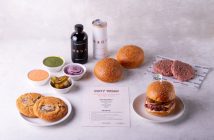What could be more cheering in the dog-end days of cold than that first sighting of Spring’s daffodils or crocuses when you are out and about on your daily routine? The first of Spring’s flowers appearing in your kitchen or cocktail, that’s what. Even though those daffs and crocuses may not be much use to the eager Spring cook Mother Nature has got it covered with a few other floral tricks up her March sleeve to brighten the plate and the palate.
Primroses and violets start to bloom in this first month of the British Spring. Both are edible so long as you make sure they have not been sprayed with pesticides. The best way to know that will be either buy from an edible flower supplier (such as Maddocks Farm or First Leaf) or use ones you have grown yourself. Any others you cannot be certain of. Maybe even ones you see growing in the wild. And in any case, it seems to me a little sad to pick primroses or violets growing in the park or countryside. If seeing them has brightened your day surely the right thing to do is leave them and let them brighten someone else’s.
Violets – which are cunningly not always violet in colour but can be pink, dark blue white or even a deep red – are surprisingly versatile in the kitchen and beyond. The Romans believed violets prevented drunkenness. To the Victorians a posy of violets represented modesty and faithfulness. They have also been thought to help ease depression and insomnia. I am rather more convinced by violets’ capabilities to enhance the flavours of chicken or fish. A small handful of chopped petals can be mixed through soft butter with lemon zest and then pushed under the chicken’s skin before cooking. Or for fish, add chopped violets to a light stuffing of breadcrumbs, lemon and some chopped mushrooms cooked in butter, and sew all that inside a whole fish before roasting it.
Violets are more simply lovely when added to Spring salads or used to decorate any savoury dish. As are the delicate yellow heads of primroses which were commonly included as part of the British kitchen gardens of the 16th century. Such a ready supply led to them being put to all kinds of use. Primrose buds were pickled and the leaves used in vinegar; they would be cooked as vegetable or fermented into wine. An infusion of primrose in hot water was even used to alleviate stress.
Our less plentiful supply may make us a bit more judicious with primroses but possibly also more appreciative of their beauty and simplicity. Two traits which are shown off to terrific advantage in primrose meringues. They are nothing more than some chopped primrose flowers folded into meringues before they go into the oven. What could be more elegant on a Spring day?
I do have an answer to that, actually. Primrose – or violet – ice-cream is pretty elegant too. Maybe not more elegant than primrose meringues but they are definitely up there. The ice-cream makers amongst you will be familiar with making the custard that gets churned up. All you have to do is infuse the custard for a while with some violet (or primrose) flowers. Serve with some of the same fresh flowers strewn over the top.
Decoration is where these flowers come into their own most often, easily and strikingly. Over savoury dishes as mentioned earlier but also all manner of cakes and desserts. The simpler the look of those without the flowers, the more effective the addition of the flowers will be. I feel that is also true of using primroses and violets to garnish cocktails. One of two of the flower heads delicately dropped into a cocktail glass is a finishing touch of an elegance to rival even those primrose meringues.
Possibly even better for decorating cocktails or desserts is to delicately frost the petals. Do that by painting egg white onto the petals and then sprinkling caster sugar over. Leave them to thoroughly dry on baking paper on a wire rack before using. Half an hour in a very low oven helps speed that drying process up.
Anyone who knows where to pick sloe berries in the late summer or autumn will also this month be able to pick the blossom from that same blackthorn bush. (I have no moral stance against picking from the public hedgerow – that’s general booty.) Using the same technique above to crystallise the blackthorn blossom gives a really seasonal garnish for a cocktail made with the last of winter’s sloe gin. It will epitomise the essence of March and its place in the handover of the seasons. Cheers to that.




